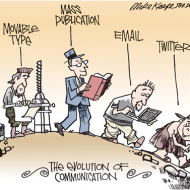Posted by Managementguru in Business Management, Entrepreneurship, How To, Organisational behaviour
on May 2nd, 2015 | 0 comments

How to effect “Effective Business Communication?” Communication is an entity much talked and debated about in corporate management circles. The question is, have you really understood what the term ‘Communication’ means, how it has evolved over all these years and the impact it creates in an organization? Well, communication is nothing but the transfer or exchange of information from one end to another end, from one user to another user or from sender to receiver to put it straight. Is that it- No! If the process could be as simple as it sounds, there should be no conflicts, no difference of opinions and no mis-understandings in this world. Are we witnessing such a peaceful scenario; In particular, office atmosphere sometimes becomes unbearable thanks to ‘clash of the so called intellectual titans’ fighting over a simple issue which could be solved by discussing it over a cup of good coffee. Now, coming back to the point, the process of communication involves the following steps, Sender- Message- Receiver I’m not quite convinced with this explanation, are you? Let us rewrite it like this, Sender- Message- Medium- Receiver- Interpretation- Feedback This somewhat makes sense because only when the message intended is interpreted rightly so by the receiver or the target, the process of communication gets completed. In olden days when only sign language was the norm of the day, people still communicated precisely through pictograms, cave paintings, ideograms and sign language. This was a form of restricted communication as people had to go to that particular place to see the message. The process of evolution has led us to what we call verbal communication, the highest form of exchanging information. More sophistication has been innovated in the technological sphere and now I’m able to write to you and publish this article from an Apple IPad, of course with references made from the web in a jiffy. Types of communication Three types of communication are present VerbalNon-verbal andWritten. Interpersonal communication is contextual: In other words, communication does not happen in isolation. There is: Psychological, which is your persona and what you bring to the interaction. Your needs, desires, values, personality, etc., all form the psychological context. (“You” here refers to both participants in the interaction.)Relational context, which refers to your reactions to the other person–the “mix.”Situational context deals with the psycho-social “where” you are communicating. An interaction that takes place in a classroom is entirely different from one that takes place in a bar.Environmental context deals with the physical “where” you are communicating. Furniture, location, noise level, temperature, season, time of day, all are examples of factors in the environmental context.Cultural context includes all the learned behaviors and rules that affect the interaction. If you come from a culture (foreign or within your own country) where it is considered rude to make long, direct eye contact, you will out of politeness avoid eye contact. If the other person comes from a culture where long, direct eye contact signals trustworthiness, then we have in the cultural context a basis for misunderstanding. Three Approaches in Communication: Linear approach: Correct communication in this perspective causes the desired effect.Production of exchange and meanings: Communicating through signs and the process of extracting meanings from these messages is called “Signification”. The interpretation can lead to very different but equally valid outcomes.How communication is used to construct our social reality: We constantly share ideas with people around, thereby constructing, re-inforcing or de-constructing our identities. This perspective sees communication as the binding force of any culture, group or society. Source- coursera.com The Semantic Noise: Another important concept in communication is the semantic theory. It is nothing but the noise created in the...


